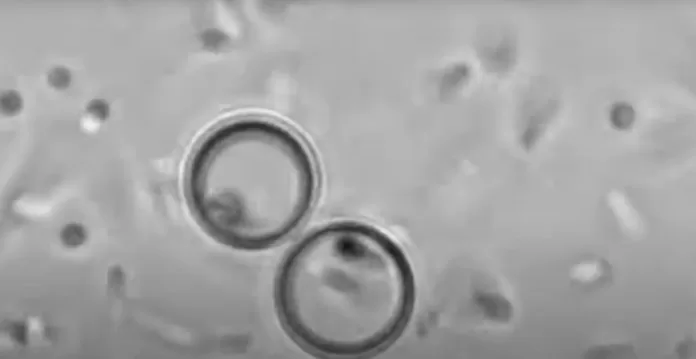Artificial cells could eat up bacteria
American Researchers have created artificial cell-like structures that can eat up, process, and push out material — recreating an essential function of living cells.
These “cell mimics” may have applications ranging from drug delivery to environmental science.
A fundamental function of living cells is their ability to harvest energy from the environment to pump molecules in and out of their systems. When energy is used to move these molecules from areas of lower concentration to areas of higher concentration, the process is called active transport. This allows cells to take in necessary molecules like glucose or amino acids, store energy, and extract waste.
Researchers at New York University and the University of Chicago created a new, fully synthetic cell mimic that is one step closer to replicating the function of living cells.
When deployed in mixtures of different particles, the cell mimics can perform active transport tasks by autonomously capturing, concentrating, storing, and delivering microscopic cargo.
The cell mimics get activated by light and act as a pump. They can remove small impurities from water, and gobble up bacteria. Read more.
Also read: ‘Countless’ interstellar objects found at edge of solar system & how bacteria make electricity
Scientists identify gene behind the stripes and spots of tabby cats
Scientists have identified the gene that gives tabby cats their stripes and spots. Although it has been well known that cats have different colours of fur because their hair follicles produce different types of the pigment known as melanin.
But the genetic basis of this pattern was not understood until now.
For the study, researchers examined foetal cat skin from embryos at different stages of development, which they obtained from cat spay-and-neuter clinics.
The embryonic skin was divided into alternating thick and thin regions. These variations corresponded to hair follicles that produce different types of melanin.
By analysing the genes of foetal cat skin cells at different levels of development, the team found that differences in the expression of the gene known as DKK4 give rise to variations in the shape and colour of cat fur patterns.
These findings may also apply to other mammals with patterned fur, according to the team. Read more.
Also read: Asteroid with shortest orbital period in solar system spotted & human DNA from 7,200 years ago
Giant meat-eating dinosaur may have dwarfed T. Rex
The iconic T. Rex have been long thought to have dominated the top of the food web at the end of the reign of the dinosaurs, but a new fossil discovered this week shows that they did not always hold that top spot.
In a new study, researchers described a new species belonging to the Carcharodontosauria, a group of medium- to large-sized carnivorous dinosaurs that preceded the tyrannosaurus as apex predators.
The new dinosaur, named Ulughbegsaurus uzbekistanensis, was found in Uzbekistan. It is estimated to have lived about 90 million years ago.
Based on a single isolated fossil — an upper jawbone — researchers estimate that it had a mass of over 1,000 kg, and was approximately 7.5 to 8.0 meters in length, greater than the length of a full-grown African elephant.
The species has been named after Ulugh Beg, a 15th century mathematician, astronomer, and sultan of the Timurid Empire of Central Asia. Read more.
NASA’s Perseverance Rover collects Mars rock samples for 1st time
NASA’s Perseverance Rover managed to collect samples of Martian rock for the first time — which will eventually be brought back to Earth to enable scientists to learn more about the Mars surface in detail.
The sample is a core — slightly thicker than a pencil — cut out from Jezero Crater. It is now enclosed in an airtight titanium sample tube. NASA and the European Space Agency are planning a series of future missions to return the rover’s sample tubes to Earth.
These samples would be the first set of scientifically identified and selected materials returned to our planet from another.
The sample-taking process began on the first of September, when the drill at the end of Perseverance’s robotic arm cored into a flat, briefcase-size Mars rock nicknamed “Rochette.”
After completing the coring process, the arm maneuvered the corner and sample tube so the rover’s camera instrument could image the contents of the still-unsealed tube and transmit the results back to Earth.
After mission controllers confirmed the cored rock’s presence in the tube, they sent a command to complete processing of the sample.
Perseverance transferred the sample tube into the rover’s interior to measure and image the rock core. It then sealed the container, took another image, and stored the tube. Read more.
Komodo dragons now a step closer to extinction
Threatened by climate change, the Komodo dragon, the world’s largest living lizard, has now moved from vulnerable to endangered on the IUCN Red List.
This means that the species, which is endemic to Indonesia and occurs only in the World Heritage-listed Komodo National Park and neighbouring Flores, is a step closer to extinction.
The species is increasingly threatened by the impacts of climate change. Rising global temperature and subsequent sea levels are expected to reduce the Komodo dragon’s suitable habitat by at least 30 per cent in the next 45 years.
In addition, while the subpopulation in Komodo National Park is currently stable and well protected, Komodo dragons outside protected areas in Flores are also threatened by significant habitat loss due to ongoing human activities.
About 25 years ago, some 5,000 to 8,000 Komodo dragons roamed the Earth. The IUCN now estimates that there are just 1,380 adult Komodo dragons and another 2,000 juveniles left in the wild.
Komodo dragons can grow up to 10 feet long and are equipped with a forked tongue, armored scales and venomous saliva. Females of the species sometimes eat their own offspring. Read more.
(Edited by Arun Prashanth)
Also read: Rare fossil turtle egg discovered, belongs to species that died when asteroid wiped out dinos



